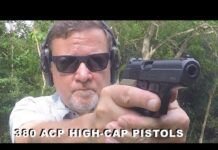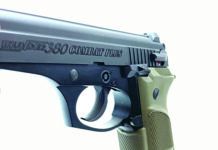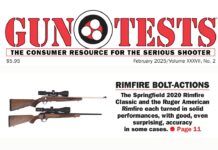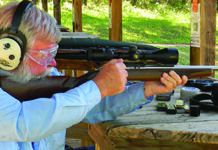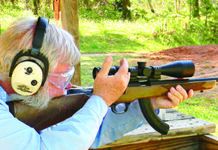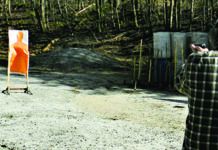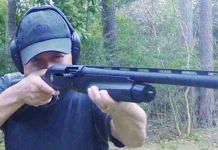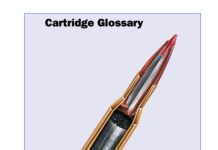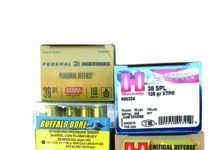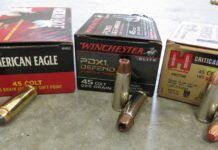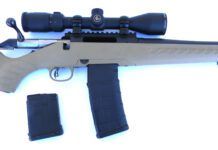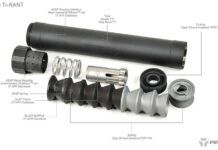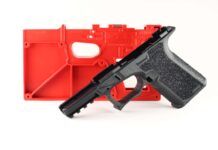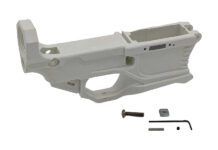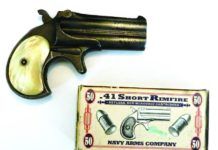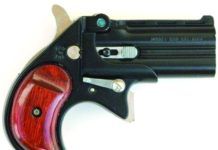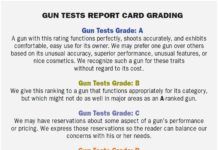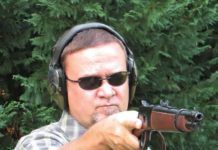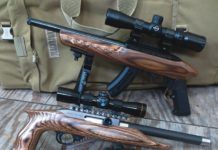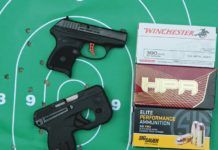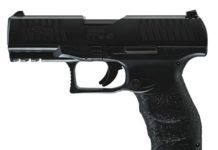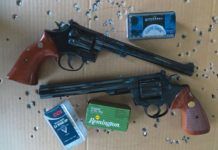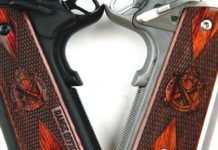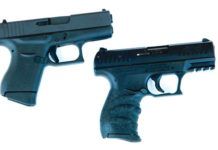Derringer Shoot-out: DoubleTap, Cobra, American Derringer Co.
Meet the derringer, an anomalous little pocket pistol of which there are many types. Gun Tests tested 3 of these handguns to see if they are worth the purchase. Turns out, they might be better for show than for showdown. The original derringer was a product of one Henry Deringer, a 19th-century maker of small muzzleloading pocket pistols. His original Philadelphia Deringer percussion-lock pistols were usually 41 caliber and varied in length from 1.5 to 6 inches. The most notable use of a Deringer was by John Wilkes Booth, who shot President Abraham Lincoln. Once cartridge guns came into being, Deringer's name was misspelled often enough to become the generic description of a small pocket pistol of limited capacity, often with a sliding or pivoting breech block. They commonly carried two shots, although some were designed for up to four shots. They were sometimes called "muff pistols" because they were carried in a muff or hand warmer used in the winter. Also, the derringer became a backup favorite of Western marshals and outlaws alike.
Among the most successful of these handguns was the Remington Derringer. In fact, the Remington's profile is associated more with the derringer than Deringer's original single-shot black-powder pistol. The Remington doubled the payload with twin barrels in the over-and-under fashion. The Remington barrels pivot upward to load and unload, and a pivoting cam on the firing pin fired first one barrel then the other. The Remington Derringer was made of iron, never steel, and was manufactured from 1866 to 1935. That is a long run for a relatively primitive handgun. The .41 Short Rimfire it fired was no powerhouse, exiting the Remington barrel at 425 fps. There have been many copies of the Remington, and two of the pistols tested in this report are copies of the Remington, namely the Cobra Enterprises CB9 Big Bore Derringer 9mm Luger, $151; and the American Derringer Company Standard Model 38 Special, which we bought used for $212. The third gun in the test was a new take on the derringer concept, the DoubleTap Defense Tactical Pocket Pistol in 9mm Luger, $499 MSRP and a $345 counter price from Cheaper Than Dirt!
The derringers were all easy to carry well, and the balance and flat profile make for a nice pocket or vest pistol. However, after testing both the derringer concept and the individual derringers, we think the money spent on these handguns would be better used elsewhere. But we graded on a "derringer" scale relative to each other, even though none of our test shooters would buy one. Here's what we found.
Handgun Stats: Cobra Enterprises CB9 Big Bore Derringer 9mm Luger, $151
The Cobra Derringer is a modern attempt to provide a useful pocket firearm. Operation is straightforward, although some attention to detail is needed to carry safely.
Within Range of California Gun Laws
See reader feedback on pistols, rifles, handguns and more! Reader John S. took our list of 380 ACPs to his local gun store in the Golden State, but his results were far from golden. Mare's Leg pistols are in fact legal for sale in California. Not all home building materials take bullets equally. And pistols that look like rifles. Lots of them.
Two Mares Legs from Henry And Rossi: Expensive Novelties
From 1958 to 1961, the TV Western series "Wanted: Dead or Alive" launched Steve McQueen's acting career, and it also laid claim to the debut of a lever-action pistol nicknamed by McQueen's character. Call it Hollywood magic or a TV set armorer's clever idea, the Mare's Leg as depicted by "Wanted: Dead or Alive" was a chopped-down Winchester Model 1892 rifle. The barrel was cut off just forward of the forearm, and the buttstock was lopped off just past the lever. The lever was also oversized, all the better to spin the shortened rifle around your hand. Please do not try spinning these shortened lever guns at home, as you might, at the very least, poke your eye out, or worse, do grave bodily harm. Also remember that Hollywood's magic had Josh Randall, Steven McQueen's character, wear 45-70 Gov't. cartridges in his Mare's Leg gun belt. The Model 1892 rifles were never chambered in that cartridge. TV Westerns back then were as popular as investigative crime shows are today and the Mare's Leg made the lead character stand out in the crowd and leave a lasting impression.
There is definitely a cool factor with the Mare's Leg, but it is an odd pistol to shoot. Using one hand means a shooter's arm quickly fatigues, unless you have the biceps of a Navy SEAL. All the weight of the pistol is forward from the shooting hand, plus when shooting these types of pistols, you need to relax your wrist somewhat to absorb recoil. Mare's Legs are heavier than a typical pistol — especially in this case, the Henry Repeating Arms Mare's Leg Model H006MML ($975), which at nearly six pounds took some muscling to aim and fire one-handed. Using two hands on the Henry or the Rossi Ranch Hand Model RH92-51121 ($597) offered more stability, with one hand on the forend and one on the grip. We even tried shooting the pistols using a one-point Blackhawk Storm Sling (70GS12BK, $34), like you might use to shoot an AR pistol. Using a two-hand hold to pull the pistol away from our body, the sling acts like a brace for more stability. So equipped, we found these pistols shone as hip-shooting designs, lightning fast but with accuracy leaving something to be desired. Many testers with lever-action rifle experience found themselves trying to shoulder the weapon, but that is not comfortable or really doable since shouldering and then levering the action would cause the bolt to come back and poke you in the eye. Suffice it to say you can shoot a Mare's Leg with one hand, but you need to use two hands to operate the pistol. Also, in case you were wondering, these are not NFA-controlled short-barreled rifles, which require payment of $200 for a tax stamp, approval from the BATFE and federal registration. A lever-action pistol is treated as a pistol by federal law, and most states allow the purchase of Mare's Leg pistols. However, California and New York have banned them. We tested these pistols using the supplied iron sights and 38 Special and 357 Magnum ammo. Here's what we found.
22 LR Pistols Based on Rifles From Ruger, MRI, and Mossberg
The Ruger 10/22 rifle is the most customizable semi-automatic rimfire rifle on the market. In fact, some manufacturers have taken 10/22 rifles and radically converted them to make highly accurate target rifles or built in internally-suppressed barrels for low-noise shooting. Some have molded shells to make the 10/22 look like an M1 Carbine or a Thompson submachine gun, while others have made them into pistols, as this test recognizes. By reconfiguring the buttstock into a pistol grip and reducing the barrel length, the same receiver is used to create an entirely different class of pistol. We wanted to take a look at these pistols, two derived from a Ruger 10/22 and one from the Mossberg 702 Plinkster, to see what they offered other than just an abbreviated variant of a long gun.
We secured a slightly used model of Magnum Research's Picuda that was mounted with a fixed 4x-power Leupold scope (#58750; $440). Ruger debuted its own 10/22 pistol in 2008, calling it the Charger, and ended production in 2012 — only to reintroduce a revised variant in 2015. The original Ruger Charger was very similar in appearance to the Magnum Research Picuda, while this new Ruger 22 Charger we tested is more refined, with plenty of features to like. Mossberg's 715P pistol came out in 2014. While the Magnum Research and Ruger are similar since they share a similar operating system, their design appeals to shooters and hunters who desire precision shooting, while the Mossberg is made to satisfy plinkers.
All three pistols use a simple blowback mechanism that is the same mechanism as used in the rifle. The pistols look ungainly since they use the same receivers as the rifles. The barrels, however, are cut down in all three models. The Magnum Research and Ruger reconfigured the rifle stock to a pistol grip sans buttstock. Though the Ruger and Magnum Research grip/stock were similar, the Ruger offered more options, so a shooter can set up the pistol to suit his shooting needs.
To make the 715P, Mossberg basically takes a 702 barreled action and sandwiches it between two polymer halves to give the pistol the appearance of an AR-15 pistol. The similarity to an AR pistol is only cosmetic, as the 715P functions just like the 702. Consider it a sheep in wolves' clothing. The Charger 22 and Picuda come optics ready, requiring a user to invest in a optic and rings. A Weaver rail is built into the Magnum Research pistol, while the Ruger comes with a Picatinny rail screwed into to the receiver. We mounted a BSA Edge 2-7x32mm pistol scope (#PS27X32; $140) on the Ruger. The Mossberg has open sights and is good to go out of the box, but to keep the playing field relatively level we added a CenterPoint Tactical 30mm Enclosed Reflex red-dot optic (Model #72601; $30). Mossberg offers a red-dot sight as an option on other 715P models. The CenterPoint optic co-witnessed with the top quarter of the iron sights on the 715P, which we liked. The rail on the Mossberg looks like a Picatinny/Weaver style, but it is not, as we discovered when mounting the CenterPoint Tactical red dot. Here's more about what we discovered about these rimfire rifles converted to pistols.
New 380 ACPs: Rugers LCP-C And Taurus Curve Shoot It Out
New 380 ACP pistols are probably responsible for the ammunition shortage in 380 ACP — our friends at the gun shops tell us that these pistols are selling fast, and with every sale, customers purchase two to four boxes of ammunition. This time, we look at the breakthrough design of the Taurus Curve, so named because its handle is made to curve and conform to the body, as long as you are right handed. Ruger has offered a number of limited editions of the LCP in the past, but for the most part, they were simply a different finish or displayed some type of logo. The new LCP Custom pistol, however, features a vastly improved trigger similar to the RTK Sweet Pea triggers many of us added to the original LCP, and the design is considerably different as well.
Walther Makes First 45 ACP Pistol
Walther's new PPQ in 45 ACP is the first true production Walther in that chambering in the company's history, Walther says. The gun is equipped with the Carl Walther quick defense trigger, traditional front and rear slide serrations, and ambidextrous controls like other PPQs. The PPQ 45 Auto will hit the market and be available in retail stores on October 1, 2015.
Cyndi Flannigan, Walther Arms' vice president of sales and marketing, says of the new pistol, "This new caliber and product offering is a benchmark for Walther and the PPQ. We have built it to the same exact German standards that have made this model so well received, and it is a superior choice for home defense and personal protection." We'll soon see about that.
A Pair of Collectible Long-Barrel 22 Magnums from S&W, Colt
In 1959 Winchester unveiled its latest brainchild, the 22 WMR cartridge. The debut of the new rimfire excited shooters since it pushed a 40-grain bullet at a velocity of 2,000 fps. A similarly size 40-grain bullet from a 22 LR at the time had a velocity of about 1,200 fps. With more speed also came good accuracy. For larger varmints like fox, raccoon, and coyote, the 22 WMR was a good choice if used at short to medium range. Plus the 22 WMR had minimal recoil and cartridges cost less than any 22 centerfire ammo.
A few months after the cartridge debuted, Smith & Wesson had a revolver chambered for it and named it the Model 48. The transition to the new round was easy for S&W since they were already manufacturing the K-22 Masterpiece chambered in 22 Long Rifle. Colt was a little behind the curve, but it did chamber the round in fewer than 1,000 of the Officer's Model Match revolvers and a very few Colt Diamondback revolvers. It wasn't until the debut of the Trooper MK III that Colt took the cartridge more seriously.
Many of our testers have experience with the round in rifles, revolvers, derringers and semi-automatic pistols. We wanted to determine what would be a good double-action revolver platform for the 22 WMR, and so we acquired two previously untested firearms, a S&W Model 48-2 and a Colt Trooper MK III, both with long 8-inch barrels. The S&W graded about 90-85% and the Colt 95-90%. These were two lovely blued revolvers with wood grips. They had obviously not been fired often, but we still went through our battery of pre-range testing of the cylinder-to-frame headspace, cylinder-to-barrel tolerance and the alignment of the chambers with the bore, using gauges from Brownells.com. All checked out fine, with the Model 48-2 cylinder gap measuring 0.002 inch and the Trooper MK III gap measuring 0.003 inch. There was no wiggle nor play in either cylinder, and they locked up tight. The screw heads on both guns also looked like they have not seen a screwdriver since the factory. These were sharp-looking revolvers in excellent condition. In doing research prior to the purchase, we collected prices for these firearms on the used market, and those price ranges are reflected in what dollar amounts we cite below:
Springfield 9mm 1911s: Loaded Versus Range Officer Showdown
There are many good reasons for purchasing a 1911 in the non-traditional 9mm Luger cartridge. Compared to 45 ACP, 38 Super, and 10mm, 9mm Luger ammunition is less expensive and easy to come by. Also, the 9mm is only improved when fired from the 1911, with that platform's solid ergonomics, reliability, and distinctive appearance. In a 1911, the 9mm is easy to shoot well, despite a history in which 9mm target guns were seldom as accurate as a properly set up 45. As it turns out, the 9mm 1911 with modern ammunition is plenty accurate. Some shooters might also worry that 9mm 1911s might be less reliable, but we can only say that in our small sample of hundreds of rounds, two tested 1911 9mm handguns were reliable.
Where do such guns fit in? For one, the 9mm 1911 is a great target and competition handgun. Just as a cowboy-action shooter may choose a 38 Special SAA for economy and low recoil, an IDPA shooter may find the 9mm affords economical practice without creating waves in the arm from recoil. The self-defense shooter need not worry either, because with +P loads, the 9mm is no slouch in the wound-ballistics department.
We have had calls to choose between two closely matched stablemates from Springfield Armory, and both the Loaded Target PI9134LP and the Range Officer PI9129LP are traditional full-size 9mm pistols. This simply means that they are based upon the 45 ACP's frame. They are very similar to 38 Super pistols, save for a breech face of 0.384 versus 0.405 inch for the 38 Super. By changing a barrel and opening the breech face, the 9mm pistol may be converted to 38 Super. As you may imagine, converting a 38 Super to 9mm is a bit easier since the larger breechface usually works okay with both cartridges. (Exceptions: The Para USA LDA 9 and the Springfield EMP 9mm are 9mm pistols that are a bit smaller in dimension than the full-size Springfield pistols. They cannot be converted to the 38 Super.)
The full-size 9mm handguns are designed to fill a niche for those favoring the 9mm, or those simply wishing to own a lighter-kicking 1911 than one chambered in 45 ACP or 40 S&W.
The 9mm Range Officer has the same forged national match frame and slide as the Trophy Match and TRP 1911s. It gets the same precision fit as those more expensive pistols, Springfield says. Likewise, it uses the same match-grade stainless-steel barrel and bushing and is topped with a fully-adjustable rear target sight. This is a great help to us in adjusting point of aim to point of impact when we're shooting different bullet weights. It has a single-sided thumb safety.
The Loaded 9mm Stainless Steel has a polished finish on the flat surfaces and bead-blasted matte finish on the rounded areas. The 5-inch barrel is a match-grade stainless steel unit. The slide features slanted serrations on the front and rear, where the RO has only rear cuts. The mainspring housing is flat and includes the company's integral locking system, or I.L.S., which replaces the mainspring housing of the handgun. When engaged, the I.L.S. prevents the hammer from moving by locking the mainspring cap, making the gun inoperable. Elsewhere, the pistol has a lightweight Delta hammer and a beavertail grip safety with raised memory pad for positive engagement. The extended thumb safety is ambidextrous, and its long aluminum match-grade trigger separate it from the RO. The pistol is fitted with a two-piece full-length guide rod. The grips are held in place with Torx grip screws that look nice and distinguish it from the RO.
During the evaluation, both handguns were field stripped. Interestingly, the Range Officer slide easily slipped on the Loaded Model Frame. The Loaded Model slide, however, was too tight on the Range Officer frame to function. Since modern 1911 handguns are not disassembled and thrown into a barrel on Guadalcanal for cleaning, then assembled regardless of original set up, this is acceptable and also interesting. The Range Officer seemed to have the tighter barrel bushing lockup. The barrel was a tight fit overall. We were surprised that the barrel bushing was only finger tight with the Range Officer.
But what matters is the shooting, and what our team found is that these 1911s chambered in 9mm Luger make for a very pleasurable shooting experience. An accurate 1911 in 9mm is even more enjoyable. Here's more of what we learned about them when firing them side by side:
Proposed Settlement Has Taurus Paying $30M
Gun maker Forjas Taurus SA has agreed to settle a $30 million class-action suit with plaintiffs who claim that some Taurus handgun safeties, even when engaged, may allow the gun to fire if it is dropped, according to a review of court documents.
California Bans Advertising of the Sale of Handguns
California has argued that a provision of California Penal Code section 26820 enacted in 1923 prevents the displaying of any "handgun or imitation handgun, or placard advertising the sale or transfer thereof" anywhere in or on their store that can be seen outside their store by passersby.
Two New 9mm Compacts from Glock and Walther Square Off
The compact 9mm pistol market is hot, and two of the newer additions to the marketplace are the Glock 43 Subcompact Slimline G43 PI4350201, $499, and the Walther Concealed Carry Pistol CCP 5080300, $452. The Glock is a long-awaited single-stack version of the other Glock pistols, but we found the G43 to be a re-engineered pistol that isn't simply a single-stack Glock 26. The frame design is a good one for personal defense if you need a pistol this size. The Walther CCP is a bit larger, so it holds two more cartridges and proved more accurate. The Walther also featured a light rail. So, in our view, we had two pistols that fit the same niche for concealed carry, but we wondered how the size and capacity issues would strike our testers.
We should mention that the raters for this test were a good mix in age and experience, from early twenties to early sixties. Among the shooters involved in this test were one with more than 40 years of shooting experience, and another has operated a respected gunsmith operation for 30 years. A third was a military intelligence officer; a fourth was a 50-ish female who carries daily, and the fifth was a college-age female who is an NRA-certified instructor.
During the firing test, both pistols were carried in a Barber Chameleon holster ($29.95, postage included, from BarberLeatherWorks.com) This affordable holster is well made of quality leather, and it offers a belt loop for use as a belt slide. There is a strong steel clip for inside-the-waistband carry. We used the holster as a belt slide for both pistols during this test.
What we didn't anticipate was the Walther getting the lion's share of attention — but not for good reasons. Because the pistol did not work to our satisfaction, we explored its operating system in depth, attempting to find remedies that we could disclose to readers who might prefer the CCP for one reason or another. Here's what we found:


